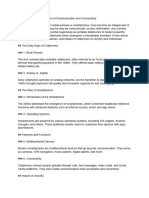Case Study: The Evolution and Impact of Cell Phones
Introduction
Cell phones, once a luxury for the wealthy and a symbol of innovation, have evolved into an
essential tool in the everyday lives of billions around the world. From their humble beginnings
as bulky devices primarily used for voice communication, cell phones have transformed into
powerful mini-computers, capable of multitasking and influencing nearly every facet of society.
This case study explores the history, development, technological advances, and societal
impacts of cell phones, providing insight into how they have reshaped communication, culture,
and global economies.
1. The History of Cell Phones
Early Beginnings
The concept of the mobile phone dates back to the 1940s when the idea of mobile
communication was first explored. However, the technological advances necessary for portable
phones were not yet available. Early mobile communication systems were based on radio
waves, but the bulky and impractical devices were only useful in limited scenarios, such as in
cars.
The first real breakthrough came in 1973 when Martin Cooper, a Motorola engineer, made the
first public mobile phone call. The device, known as the Motorola DynaTAC, was large, weighing
over 2 pounds, and had a battery life of just 30 minutes. Despite these limitations, it was
revolutionary, laying the groundwork for future advancements in mobile technology.
The Development of the Cellular Network
The development of cellular networks began in the 1980s. Before this, mobile phones relied on
a direct radio connection to a base station, which was inefficient and prone to interference.
Cellular networks allowed for multiple users to share the same frequencies by dividing coverage
areas into smaller cells. This technology made mobile communication more scalable and
practical.
In 1983, Motorola released the first commercial cellular phone, the DynaTAC 8000X. It was still
large by today's standards, but it marked the beginning of the commercialization of cell phones.
At this time, mobile phones were still relatively expensive and limited to business professionals
and the wealthy.
The Rise of the Mobile Phone Industry
In the 1990s, mobile phones began to become more affordable, and their capabilities
expanded. The advent of digital cellular networks, such as GSM (Global System for Mobile
Communications), allowed for more efficient use of spectrum and improved call quality.
�Phones became smaller, more reliable, and began incorporating features beyond simple voice
communication, such as text messaging.
By the late 1990s and early 2000s, the mobile phone industry began to experience rapid growth.
The introduction of the first smartphones, with integrated email, cameras, and internet
connectivity, marked the beginning of a new era. Companies like Nokia, Motorola, and Ericsson
dominated the market at the time, setting the stage for future competition and innovation.
2. Technological Evolution of Cell Phones
The Birth of Smartphones
In the early 2000s, mobile phones transitioned from simple communication devices to
multifaceted gadgets capable of handling a wide range of tasks. The launch of the iPhone in
2007 marked a watershed moment in this transformation. Apple's introduction of a touch-
screen interface, combined with internet browsing, email, and a growing range of downloadable
applications, revolutionized how people interacted with their phones.
Before the iPhone, devices like the BlackBerry were popular for their email capabilities, while
Nokia’s Symbian phones offered a more basic level of functionality. However, the iPhone’s sleek
design and intuitive interface set a new standard in the mobile industry. This ushered in an era of
mobile computing where smartphones became an indispensable part of daily life.
Mobile Operating Systems: Android vs. iOS
One of the key developments that fueled the growth of smartphones was the introduction of
mobile operating systems, which allowed users to download and install applications. Apple's
iOS, introduced in 2007, quickly became the most popular operating system, primarily due to
the success of the iPhone. This dominance was challenged by the emergence of Google’s
Android operating system in 2008, which was an open-source platform that allowed multiple
manufacturers to create smartphones running Android.
The competition between iOS and Android drove innovation, leading to the introduction of
features such as app stores, mobile payment systems, virtual assistants, and improved
hardware. The app economy exploded, with millions of apps now available, transforming
smartphones into tools for gaming, productivity, navigation, social networking, health tracking,
and more.
Advancements in Mobile Hardware
Alongside operating systems, mobile hardware also saw significant advancements. The early
mobile phones featured simple LCD screens, limited processing power, and basic cameras.
However, as technology improved, cell phones began to incorporate high-resolution
�touchscreens, faster processors, more powerful GPUs (Graphics Processing Units), and
sophisticated camera systems capable of capturing high-quality images and videos.
The rise of 4G and 5G networks further transformed mobile phones, enabling faster data speeds
and making it possible to stream content, engage in video calls, and play high-definition games
seamlessly. 5G, in particular, promises to revolutionize the way we use mobile devices by
enabling faster download speeds, lower latency, and increased connectivity, potentially
unlocking new possibilities in areas like autonomous vehicles, smart cities, and IoT (Internet of
Things).
3. The Social Impact of Cell Phones
Communication and Connectivity
Perhaps the most significant impact of cell phones is the way they have transformed
communication. What began as a tool for making voice calls has evolved into an all-
encompassing device that allows people to stay connected through text messages, video calls,
emails, and social media platforms. The convenience of mobile communication has reduced
geographical barriers and allowed individuals to maintain personal and professional
relationships regardless of location.
Moreover, smartphones have made it easier to communicate across cultures and languages.
Translation apps and real-time messaging services have opened up global communication in
unprecedented ways, bridging the gap between people who speak different languages.
Social Media and Networking
Social media platforms such as Facebook, Twitter, Instagram, and TikTok have become integral
to daily life, largely because of their accessibility on mobile devices. Social media has not only
changed how we communicate but also how we engage with news, entertainment, and culture.
With the widespread use of smartphones, individuals can now share their lives and ideas
instantly with a global audience.
The rise of social media, facilitated by cell phones, has had both positive and negative
consequences. On one hand, it has democratized information and given people a platform to
voice their opinions. On the other hand, concerns about privacy, cyberbullying, and the spread
of misinformation have arisen.
Education and Productivity
Cell phones have significantly impacted education by providing access to online learning
platforms, educational apps, and research tools. In many parts of the world, mobile phones
�have become a primary means of accessing educational resources, especially in regions with
limited access to traditional computers or internet infrastructure.
Smartphones have also revolutionized productivity, enabling individuals to manage their
schedules, check emails, collaborate on documents, and access professional tools on the go.
Mobile applications have made it easier for people to work remotely, creating a more flexible
and connected workforce.
Health and Well-being
The impact of smartphones on health and well-being is another important area of focus. On one
hand, cell phones have facilitated access to health information, telemedicine services, and
fitness tracking apps. The availability of health-related apps has allowed users to monitor their
physical activity, track their diet, and manage chronic conditions.
On the other hand, there are concerns about the negative effects of excessive mobile phone
use, particularly on mental health. Studies have linked heavy smartphone use to increased
stress, anxiety, and sleep disturbances. The constant connectivity facilitated by smartphones
can lead to information overload and a sense of being perpetually "on-call," which can be
detrimental to well-being.
4. The Economic Impact of Cell Phones
The Mobile Phone Industry
The mobile phone industry has become one of the largest and most influential sectors globally.
Major companies such as Apple, Samsung, and Huawei dominate the market, driving
innovation and competition. The smartphone market is also supported by a vast ecosystem of
suppliers, app developers, mobile network operators, and accessory manufacturers,
contributing to a multi-trillion-dollar global industry.
In addition to manufacturing, the rise of mobile apps has led to the creation of millions of jobs in
the app development, marketing, and service industries. The app economy is a significant driver
of economic growth, particularly in regions like Silicon Valley in the U.S., where tech companies
lead the development of mobile solutions.
Mobile Commerce and Payment Systems
Cell phones have revolutionized the way people shop, bank, and make payments. Mobile
commerce (m-commerce) has become a multibillion-dollar industry, with smartphones
enabling consumers to shop online, pay bills, and transfer money instantly. Mobile payment
systems such as Apple Pay, Google Wallet, and PayPal have made it easier to make secure
payments without the need for cash or credit cards.
�In emerging markets, mobile banking and payment systems have become a lifeline for
individuals without access to traditional banking services. Services like M-Pesa in Kenya have
empowered millions of people to send money, save, and access financial services through their
mobile phones, further boosting economic inclusion.
5. Future Trends in Cell Phone Technology
The Evolution of 5G and Beyond
The next frontier in cell phone technology lies in 5G networks, which promise to offer ultra-fast
data speeds, low latency, and greater connectivity. This will enable new technologies such as
augmented reality (AR), virtual reality (VR), and the widespread adoption of smart devices that
rely on fast, stable internet connections. As 5G networks are rolled out globally, mobile phones
will become even more powerful tools for communication, entertainment, and productivity.
Foldable and Flexible Phones
One of the most exciting developments in the smartphone industry is the rise of foldable and
flexible screens. Manufacturers like Samsung and Motorola have released devices with foldable
screens, allowing for larger displays that can be compacted into smaller, more portable
devices. This could signal a new direction in mobile design, with future phones offering more
versatile and durable form factors.
Artificial Intelligence and Mobile Phones
Artificial intelligence (AI) is another area where mobile phones are expected to evolve. AI-
powered features, such as voice assistants, facial recognition, and personalized
recommendations, are already present in smartphones. As AI technology advances,
smartphones will become even smarter, anticipating user needs, improving camera
performance, and optimizing device efficiency based on user behavior.
Conclusion
Cell phones have come a long way from their inception as bulky devices for making phone calls.
Today, they are integral to communication, entertainment, commerce, and nearly every aspect
of modern life. As technology continues to advance, the future of mobile phones promises even
greater capabilities, from 5G networks to foldable designs and AI integration. However, as their
impact on society continues to evolve, it is essential to consider the social, economic, and
health-related implications of mobile technology. The story of cell phones is not just one of
technological innovation; it is also a reflection of the changing way we live, work, and connect
with the world around us.























































































